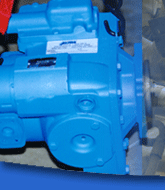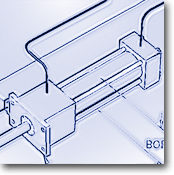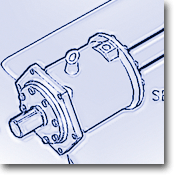

There are open-loop and closed loop control systems. The open loop systems are those without close accuracy of control. In the section following we are presenting material to develop an understanding of both open and closed-loop systems.
Open Loop Proportional Control
To control a proportional valve the maximum electrical power required
is about .125 watt, which can be supplied through a potentiometer from
a 12 volt battery. These valves can also be fully controlled by a similar
arrangement from a 4 volt miner’s cap battery. The valve can be
made intrinsically safe by adding Zener diodes across the torque motor
coils.
The circuit is a Wheatstone bridge with the potentiometer forming two adjacent arms of the bridge.
Valves can be stacked. The stack is connected with a single pressure and a single return hose. When the load demand regulator is used, one additional small line per stack is necessary to connect to the pump pressure regulator.
The single lever control stations can also be stacked in a family in-line arrangement. Two-axis joy stick controllers are also available as are up to six multi-axis hand held controllers.
Open Loop Versus Closed Loop
Before proceeding to describe various control circuits for systems, another
ambiguous set of nomenclature must be identified. This is open-loop versus
closed-loop.
For years practitioners of hydrostatic controls have used the phrases open-loop or closed-loop systems to describe whether or not a second hydraulic control line is connected between the pump and the motor. Unfortunately, in the broader world of automatic controls (of which hydrostatic controls are only a small corner), the phrases open and closed-loop describe whether or not feedback is used to sense the controlled variable. For our purposes here we will use these more broadly accepted definitions.
Open Loop Hydrostatic Control
Simple connection of a potentiometer and battery to a hydraulic pump containing
an electric controller gives remote velocity control for a hydraulic motor.
Control is open-loop. If the engine slows down, or if the load builds
up, then the load velocity will change. Of course the operator may “close
the loop” by observing the output velocity and moving the control
lever to compensate, but this is not automatic feedback control.
Closed Loop Hydrostatic Control
If a tachometer is attached to measure the speed of the hydraulic motor,
then the tachometer signal can be fed back and compared with (subtracted
from) the command signal. The resultant error signal is amplified and
used to drive the pump controller. Best performance will be achieved if
the amplifier has integral control. In this case the amplifier supplies
a continuously increasing amount of current to the controller whenever
a steady velocity error exists. This system is called a velocity servo.
The other common type of servo is the position servo. In a position servo
the signal from a potentiometer, or other source, sets the desired position
of the load driven by a hydraulic motor (or cylinder and piston if preferred).
Another potentiometer or other position measuring transducer (like an
LVDT or DCDT) is attached to measure the load position. Again, this output
signal is fed back, compared to the command signal, and the difference
signal is amplified to drive the controller.
The primary advantage of closed-loop control is improved accuracy. Any
drifts in the controller, or losses in the hydraulic pump or motor,
or
loading down of the drive, are automatically detected and the controller
current is adjusted to offset the change.
[ < back to top ]
Electrohydraulic Control Systems (EHC)
When closed-loop electrohydraulic control systems first began to appear in industry, the applications were generally those in which very high performance was required. While electrohydraulic servos are still heavily used in high-performance applications such as the machine-tool industry, they are beginning to gain wide acceptance in a variety of industries. Examples are plastics, oil exploration, mining, automotive testing, materials handling, and mobile equipment. In some cases the customer has need for performance which simply cannot be achieved with open-loop hydraulic controls or with other types of closed-loop controls. In other cases, complicated hydraulic circuitry can be replaced by electronic logic, resulting in improved reliability and lower cost. In any case it is often difficult for the potential user to assess what performance he can expect from closed-loop electrohydraulic controls, or indeed whether he should even consider using them.
Our purpose is to provide the potential user with the means to make rough performance estimates for the most basic types of servos. Of course, there are endless variations of the basic types, and detailed performance prediction can often be a complex business.
Because of this, the estimation techniques offered should not be considered a substitute for the services of a competent servo engineer.
What is a Servo?
In its simplest form, a servo (more properly, a “servomechanism”)
is a control system which measures its own output and forces the output
to quickly and accurately follow a command signal. In this way, the effects
of anomalies in the control device itself and in the load can be minimized,
as can the influence of external disturbances. Servos can be designed
to control almost any physical quantity, e.g. motion, force, pressure,
temperature, electrical voltage, or current.
These control systems are servos designed to control mechanical loads.
When rapid, precise control of sizable loads is required, an electrohydraulic
servo is often the best approach to the problem. The basic elements of
such a servocontrol system are the input command signal, servoamplifier,
actuator, external disturbances, load, feedback transducer, and the feedback
signal.
The output of the servo is measured with a transducing device to convert it to an electrical signal. This feedback signal is compared with the command signal, and the resulting error signal is then amplified and used to drive the servovalve. The servovalve controls the oil flow to the actuator in proportion to the drive current from the amplifier. The actuator then forces the load to move. Thus, a change in the command signal generates an error signal which causes the load to move in an attempt to zero the error signal. If the amplifier gain is high, the output will very rapidly and accurately follow the command, even in the presence of such annoyances as servovalve null shift and load friction.
External disturbances can cause the load to move without any change in the command signal. To offset the disturbance input, an actuator output is needed in the opposite direction. To provide this opposing output, a finite error signal is required. The magnitude of the required error signal is minimized if the amplifier gain is high.
Ideally, the amplifier gain would be set high enough that the accuracy of the servo becomes dependent only upon the accuracy of the transducer itself. In practice, however, the amplifier gain is limited by stability considerations. In some applications, stability may be critical enough that the desired performance is not possible, even with closed-loop control. That is, closed-loop control is not a remedy for all difficulties. Performance estimates are usually made for the three most common types of electrohydraulic servos:
- Position (linear or angular)
- Velocity (linear or angular)
- Force (or torque)
 |
Click
on images |
 |
Linear
System |
Rotary System |
Estimates are first made for the linear cases, and conversions are later given for the corresponding angular quantities. See your account specialist for details on how we can help you develop your system.
Proportional Electrohydraulic Control Valves
A more common bidirectional, proportional interface device is the torque
motor. The term torque motor is misleading in that the armature of the
motor moves (rotates) only a few minutes of an arc, but the torque created
on the armature is proportional in amplitude and direction to the value
of current in the coils. Torque motors are generally compact, have high
torque-per-unit current, and have dynamic response that is more than adequate
for most hydraulic applications (usually to several hundred hertz).
Other interface devices include moving voice coils and rotary electrical motors. Voice coil devices are larger than torque motors (for the same force output) and are sensitive to acceleration. Rotary electric motors are more complex and inherently have friction which reduces their performance and life.
Pilot Stages
Most electrohydraulic remote controls include a pilot stage between the
electromechanical interface device and the hydraulic component being controlled.
The pilot stage is sometimes called a hydraulic amplifier as it is supplied
with hydraulic power (pressure P and return R), and this power is modulated,
or controlled, by the mechanical output of the electromechanical device.
The result is rather large hydraulic pressures which can develop high
force to control the hydraulic equipment.
A typical pilot stage is a double nozzle and flapper. Two fixed orifices and two variable orifices are arranged in a Wheatstone bridge circuit. Flapper motion causes the output port pressures to swing one way or the other.
Other types of pilots include jet-type (where the momentum of a jet of fluid that falls on a receiver is controlled) and small sliding spools. Generally jet-type pilot stages do not work well at low temperatures (<0°F). Sliding spool valves are not preferred for direct control by a torque motor or other electromechanical devices as spool friction (which can become severe with fluid contamination) can represent a sizeable portion of the maximum driving force.
Incidentally, a 4-way pilot stage or valve has 4 ports: P pressure, R return, and two control ports. A 3-way pilot has only one control port. So a single nozzle, flapper, and one fixed orifice form a 3-way pilot stage. Likewise, a valve spool with pressure, return, and one control port is called a 3-way valve.
Solenoid Valves
The most common components used for hydraulic control are listed below.
On/off valves are generally solenoid controlled, often through a poppet-type,
3-way pilot. Because of the inherent full-on or closed-off nature of these
valves, their use is generally restricted to open loop control. Examples
include positioning booms in small utility trucks and material loaders;
operating accessories such as outriggers and winches; and switching hydraulic
circuits (controlling blocking valves, bypass valves, etc.).
Solenoid valves are available for both AC and DC operation at a number of different voltages. Most solenoid valves require several watts of electrical power, so require the use of a relay for control.
Human operators often achieve quasi-proportional control using solenoid valves by turning the valves rapidly on and off, or by jogging the valves when trying to improve feathering or resolution. Dual solenoids on a single directional valve are necessary for forward/off/reverse control.
[ < back to top ]
Proportional Valves
Four-way directional valves which have an electrically operated pilot stage, and give valve spool position proportional in magnitude and polarity to the electrical input, are called proportional valves. These valves differ in the type of pilot used, the spool configuration used, and the mechanism employed to give proportionality.
Different types of pilot stages were discussed previously. In proportional valves the pilot stage may be separately pressurized by a pilot pressure supply (generally 1000 psi or higher for best performance), or it may be supplied from the normal valve supply pressure. The pilot stage requires good filtration so a separately pressurized pilot allows use of a low capacity, fine filter, rather than filtering full flow on the pressure side.
Spools for proportional valves may have most any configuration. Tandem center spools are used with constant flow hydraulic supplies. These spools have a bypass from pressure to return when the spool is centered in order to unload the hydraulic supply. As the spool moves to either side of center, the bypass closes-off and this builds up pump pressure throughout the hydraulic system upstream of the valve.
Open Center and Closed Center Valves
Spool configurations for proportional valves operating on constant pressure
systems are either open center or closed center. Unfortunately this nomenclature
is often confused with the same terms used to describe two types of hydraulic
supply.
An open center spool has both control ports open to return when the spool
is centered. The pressure lands are usually overlapped so that 10% to
20% of spool travel is necessary to open a cylinder port to pressure.
This spool configuration is always used to operate a man lift as the open
center insures operation of load holding valves at the lift cylinders
(which are required by OSHA/ANSI).
Open center spools usually have shaped control slots so that flow from the valve builds up more gradually when the valve is near its center position. Closed center spools give very linear flow versus spool position. This linearity does not give very normal “feel” for a human operator, but it does produce good closed-loop servocontrol.
Constant Flow Versus Constant Pressure Hydraulic
Systems
The majority of mobile hydraulic systems in use today have tandem center
directional valves with constant flow hydraulic supplies. Why, then, have
some manufacturers introduced electrically controlled proportional valves
for constant pressure systems? The reason is better performance. Also,
remote controlled tandem center valves require a separate pilot pressure
which usually means a separate pump.
A constant pressure supply can be obtained by a pressure compensated pump, or by an accumulator unloading scheme, or by bypassing full pump flow over a pressure relief valve. The first two pumping schemes are usually more expensive than a simple fixed displacement pump system, and the third scheme produces needless power loss (together with noise, heat, and wear).
Another alternative that provides the best of both worlds is provided by a load demand pressure regulator on a constant flow hydraulic supply. The result is a “constant” pressure hydraulic system (all valves have the same supply pressure), where the actual pressure changes to accommodate the maximum load. Standby pressure is essentially the same as the losses in a tandem center valve system (200-300 psi). Pump pressure builds up as required by the load, but the performance of all control valves is immediate and non-interactive as with a true constant pressure supply.
Proportional Operation
Proportional valves have either of two different mechanizations: (a) spring
centered spools, or (b) “free floating” spools with mechanical
feedback. Spring centered spools merely move to a position corresponding
to the pressure produced by the pilot stage (presuming there is negligible
spool friction). This valve configuration requires good linearity and
repeatability from the pilot, which can be a problem over wide ranges
of temperatures and pressures.
The preferred technique is to allow the spool to move freely (small detent
centering springs are usually included to insure centered spool with pressure
off). Only small pilot pressures are normally necessary to move the spool.
Movement of the spool creates a feedback torque on the torque motor that
counteracts the electrical input torque, so the spool stops at a position
proportional to the value of input current.
This valve configuration has the advantage of being able to build up large pressures on the spool if necessary to move it. Also the performance of the pilot stage is not critical.
Proportional Pumps and Motors
Hydrostatic controls using variable displacement pumps, or motors, or
both, are another type of hydraulic component for which remote control
is becoming increasingly popular. Conventional hydrostatic pump and motor
controls use one or two pistons to move the variable stroking mechanism,
a valve to control the pistons, and a mechanical linkage to position the
valve.
Electrical remote controls for hydrostatic pumps and motors are provided
by a proportional valve mechanism like that previously described. In this
case, however, it is necessary to have the position of the pump stroking
mechanism proportional to the electrical input, so a lever and spring
connect from the stroking mechanism to the torque motor. When an electrical
signal is applied, the valve will act. This causes the stroking mechanism
to move until it reaches a displacement where the feedback spring just
counteracts the electrical input torque. At this point the valve has moved
back to near its centered position.
[ < back to top ]
| Home | Markets | Product Solutions | Corporate | Customer Support | Downloads | What's New | Contact Us |